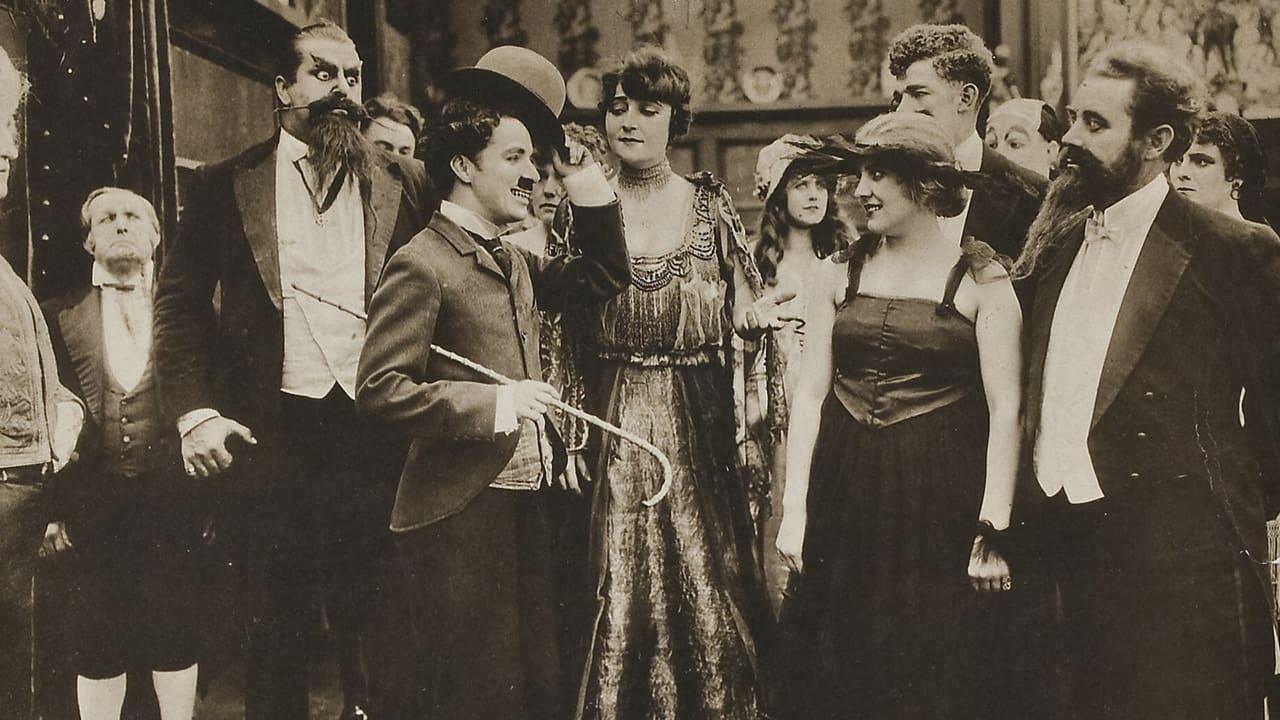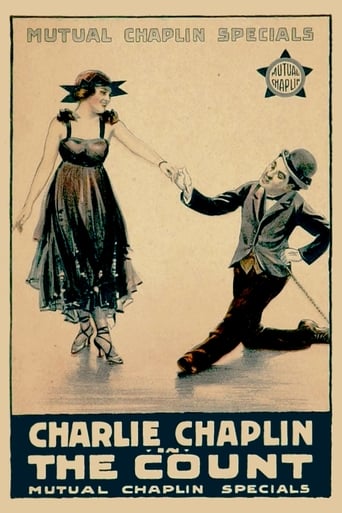

"The Count" is another Charlie Chaplin 20-minute short film. It was made in 1916, almost 100 years ago or maybe over 100 years already when you read this review. It was silent and black-and-white obviously and is considered one of the films Chaplin made during his strongest years before his full feature film career. Sadly, I cannot agree in this very particular case. I found this one of his more forgettable films. Purviance and Campbell are welcome additions as always, but I am not too big on Chaplin films that are basically nothing but a collection of slapstick and other comedic elements. It would have been nice to actually see a better storyline in this one here. Not recommended and I suggest you check out some of his superior short films. There are enough that fit this description.
... View MoreTHE COUNT (Mutual Studios, 1916), Written, Directed and starring Charlie Chaplin, has the legendary comedian at it again in his fifth of twelve comedy shorts for Mutual. Not exactly doing a spoof on Count Dracula nor The Count of Monte Cristo, The Count in this comedy happens to be a man Charlie impersonates only by accident.Charlie is introduced as an assistant tailor whose method of measuring one of the female customers and burning a handful of clothes with an iron gets him fired by his stern employer (Eric Campbell). While getting fired seems to take part of his every day existence, rather than looking for another job, Charlie comes to an estate to pay a visit to his lady friend (Eva Thatcher) who not only works there as a cook, but entertains other gentlemen callers as well. In the meantime, the head tailor discovers a note in the suit belonging to one of his customers, Count Broko, addressed to Mrs. Moneybags explaining he cannot attend a function where he's to be introduced to her wealthy daughter. Seeing this the opportunity for richness, the tailor takes it upon himself by dressing up to impersonate the honored guest and come to the society party himself. As fate would have it, the Moneybags estate happens to be where Charlie is visiting. An accidental meeting has Charlie passing himself off as Count Broko with his ex-boss being his personal secretary rather than the other way around as originally intended. As the function gets underway, the two rivals begin to vie for the affection of Miss Moneybags (Edna Purviance), but things don't go on as initially planned.For a Charlie Chaplin comedy, Charlie Chaplin naturally is the whole show. His show is commonly shared by an assortment of Chaplin stock players of featured support consisting of familiar faces of Albert Austin (The Guest); Frank J. Coleman (The Policeman); Leo White (Count Broko); Charlotte Mineau (Mrs. Moneybags); James T. Kelly (The Butler). Chaplin antics consist attempting to eat Limburger cheese; eating at a society function and his method of eating watermelon; his style of dancing with Miss Moneybags; and situations leading to a latter-day Three Stooges-type of finish. While some clever sounding names as Moneybags were used for the society family, it's interesting that Chaplin didn't come up with names of Taylor the Tailor for either himself or Eric Campbell.As usual, Chaplin and Campbell, rivaling each other for the affections of a society girl, are highlights of the evening. No doubt their physical union were the inspiration of the much latter cartoon escapes of sailors, the short Popeye and the tall, rugged and bearded Bluto. While Popeye ate spinach as his method of strength and fight, Chaplin uses clever ideas and swift kicks when necessary for his.Many years after its release, THE COUNT had been broadcast on television in various formats: prints from 1930s reissue with orchestration and sound effects commonly found on public television in the sixties and seventies, and later on home video through Blackhawk or Republic Home Video in the 1980s and 90s; different orchestration for the syndication and later PBS television program of "Charlie Chaplin Comedy Theater" (1960s); and restored visual copies from KINO Video with new orchestration used for both VHS or DVD formats with corrected silent speed extending the standard 21 minute short to 24, among others. The KINO format is the one often used on Turner Classic Movies cable channel (TCM premiere: December 6, 1999).A society comedy which Chaplin would attempt again, THE COUNT, though average, does have some moments of fun and amusements. With perfectionist Chaplin improving himself from one film after another, better comedies lay ahead. Next Chaplin Mutual comedy: THE PAWN SHOP (1916). (***)
... View MoreCharlie Chaplin's fifth film for Mutual is a somewhat simpler film than its immediate predecessors The Vagabond and One A.M. and is more reminiscent of his Essanay work, albeit it more sophisticated and slightly funnier. Chaplin plays an inept Tailor's assistant who gets fired for burning a Count's trousers. His boss (Eric Campbell) finds an invitation to a party at the house of Miss Moneybags (Edna Purviance) and decides to impersonate the rich Count in order to marry the attractive, rich girl. Chaplin is also at the party having snuck in through the back door and beats Campbell to the impersonation. All hell breaks lose though when the real Count arrives, along with the Police to chase out the impostors.The Count features lots of funny moments but lacks the knockout blow of the likes of One A.M. or The Bank. It's testament to the quality of Chaplin's Mutual films that I felt disappointed by The Count even though it is far superior to a lot of his Essanay work.Although there were no huge laughs to be found here I still chuckled a lot. For me the funniest scene was the opener in which Chaplin is taking a woman's measurements. First he measures her ears, then her lips before mistakenly giving her a five foot waste and finishing off by measuring one finger. It was totally bonkers. I also liked his embarrassment with regards to going near any of her more private areas and measured her bottom with a ruler from about four feet away. Another funny scene comes late on in the final chase. Here Chaplin is chased through a house and across a slippery dance floor in a very well choreographed sequence.There are obvious comparisons to be made between this film and A Jitney Elopement in which Chaplin again impersonates a Count to gain Edna Purviance's affections. Chaplin is able to create humour in both films around the dinner table, a trait that continued into the rest of his career. Personally I prefer A Jitney Elopement to The Count but both films have their merits.One final thing of note here is Eric Campbell's beard. It is simply extraordinary even by his standards. I've never seen anything like it before. Ridiculous facial hair is something that is evident in most of Chaplin's earlier films but I think it reaches new levels in The Count.www.attheback.blogspot.com
... View MoreMonday Septembeer 17, 7:00pm, The Paramount TheaterAn enormous tailor (Eric Campbell) impersonates Count Broko in order to attend the party of beautiful heiress, Miss Moneybags (Edna Purviance). He discharges his assistant (Charles Chaplin) for incompetence, then discovers him at the party. The tailor pleads with his former employee to pose as his secretary, but Charlie rushes instead to announce he is the Count, and a competition for Miss Moneybag's attention ensues. When the real Count (Leo White) arrives, the tailor is arrested, while Charlie waddles down the sidewalk and into the distance. In The Count, Chaplin revisits the theme of the role playing impostor intruding on the upper classes as he satirizes established social conventions. He invents bizarre dining etiquette as he shares a meal while seated between the tailor and the composed but concerned heiress, then vies with another guest (Albert Austin) for her attention on the impossibly slippery floor, in an outrageous dancing finale.
... View More